5. Scotland's Key Transport Hubs
Transporting Scotland's Trade 2019 Edition
5. Scotland's Key Transport Hubs
This chapter provides an overview of some of Scotland's ports, airports, and road and rail terminals which play a vital role in handling Scotland's freight.
Scotland has a variety of hubs and terminals situated across the country in prime locations for import and export freight. The central belt between Glasgow and Edinburgh is Scotland's most populated region with many international businesses and logistics firms headquartered within the region.
The first edition of Transporting Scotland's Trade looked into some of these logistical hubs such as Eurocentral – Scotland's largest commercial site with many international logistics companies operating out of its premises – and Hillington Park. This edition will look more closely at the terminals and hubs included in the previous edition of Transporting Scotland's Trade, while also considering the following additional hubs:
- Clyde Ports
- Glasgow Airport
- Aberdeen Airport
- Inverness Airport Business Park
- Grangemouth
The information in this section provides a background to how goods move around Scotland and outlines some of the locations where consolidation takes place.
Aberdeen Harbour
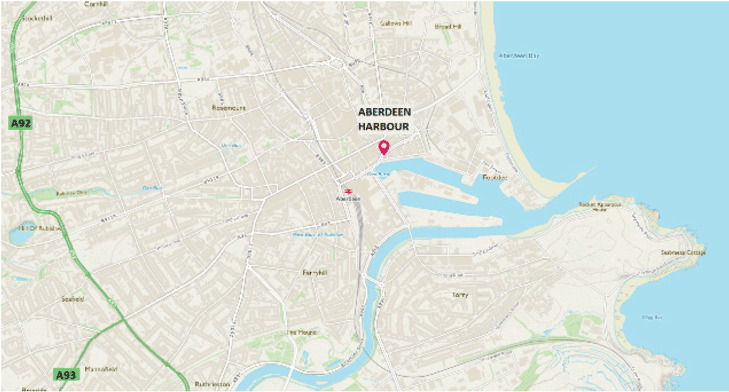
Aberdeen Harbour is the principal commercial port serving the north east of Scotland and is one of Europe's leading marine support centres for offshore energy. Operated by Aberdeen Harbour Trust and located in Aberdeen city centre, it handled over 9,200 vessel arrivals and more than four million tonnes of cargo in 2018, valued at approximately £1.5 billion. In the same year, Aberdeen Harbour had 37 shipping connections to countries in almost every continent, including Brazil, Ghana, Australia, Canada and Japan.
The harbour is estimated to support 12,000 jobs in the Scottish economy, with 9,565 of these jobs within the Aberdeen City and Aberdeenshire economies. It is the key hub for the servicing and the decommissioning of oil and gas platforms in the North Sea, and is also one of Europe's leading marine support centres for offshore energy. It is a major port of departure for the Baltics and also Scandinavia. Major exports include fertiliser, granite, and chemicals.
The harbour is close to the A90 and A96. The A90 is the main arterial route into the city from the north and south, linking Aberdeen to Edinburgh, Dundee, Brechin and Perth in the south and Ellon, Peterhead and Fraserburgh in the north. The A96 which starts in the city centre runs north to the Moray coast and Inverness. Aberdeen railway station and depot is located adjacent to the harbour.
The harbour is currently being extended into nearby Nigg Bay. This project is due to be completed in 2020 at the cost of £350 million and will provide a facility for oil industry decommissioning work and cruise ships.
The Serco Northlink Ferry (SNF) Service to Orkney and Shetland operates up to 7 passenger and vehicle sailings a week from Aberdeen. SNF freight vessels to the islands also operate from Aberdeen and currently there are daily sailings during peak months to service Kirkwall and Lerwick's livestock transportation needs.
Aberdeen International Airport
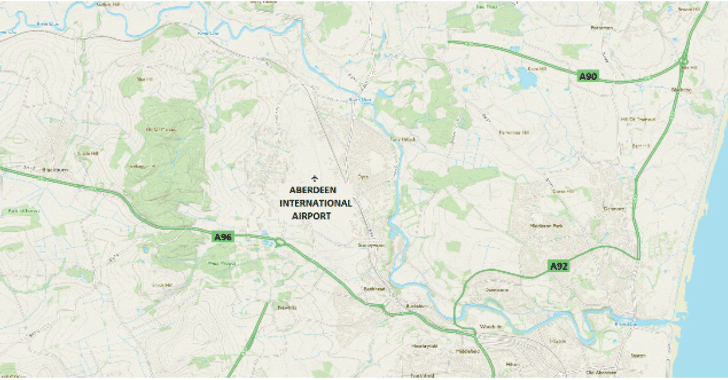
Aberdeen International Airport is located just 8 miles from the north east coast of mainland Scotland and is accessible via the A90 and A96. The airport provided services for over 3.1 million passengers in 2018, lifting over 5,700 tonnes of air cargo. The airport contains 3 helicopter terminals, linking oil rigs offshore to the mainland.
In 2018, of the 5,707 tonnes of freight lifted (both directions) at Aberdeen Airport, 4,058 tonnes (71%) was domestic freight that stayed within Scotland. The majority of the remaining freight (1,478 tonnes) was coming from or going to non-EU destinations with only 171 tonnes of freight coming from or going to the EU.[47]
The airport has supported freight movements for many years and also supports the movement of people to and from offshore oil rigs. The majority of freight lifted at Aberdeen airport is on dedicated cargo aircraft as opposed to in the hold of passenger aircraft, accounting for roughly 64% of all air freight movements from Aberdeen airport in 2018. However, compared with the previous year, 17% more freight went in passenger aircraft while the tonnage on cargo aircraft fell by 11%.
Port of Cairnryan and Loch Ryan Ports
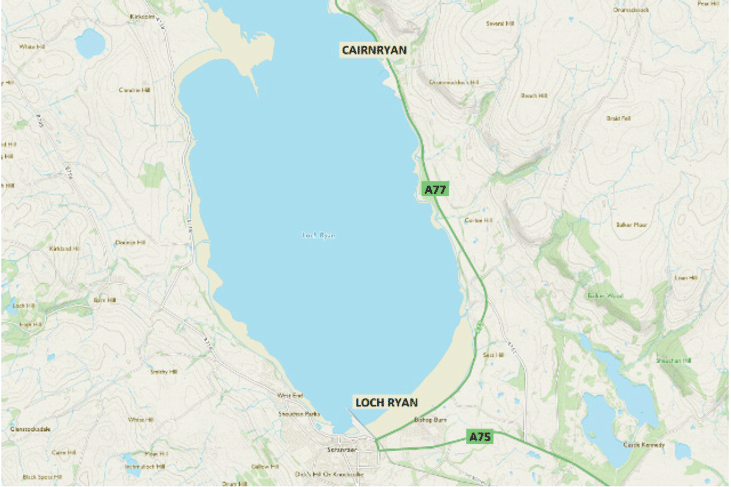
Port of Cairnryan and Loch Ryan Port are the main ports carrying passengers and goods between Scotland and Northern Ireland. Located approximately 80 miles south west of Glasgow on the A77, and 6 miles north of Stranraer on the eastern shore of Loch Ryan, there are two ferry terminals at the north and south of the village of Cairnryan. The Port of Cairnryan, which was opened in 1973, is operated by P&O Ferries, with services to the port of Larne. The Loch Ryan Port, is operated by Stena Line linking to the Port of Belfast.
The two terminals combined represent the third busiest port in the UK for carrying goods to and from the island of Ireland with around 400,000 freight units carried on this corridor each year (with Liverpool the busiest, followed by Holyhead). There are 13 daily crossings in each direction on this corridor providing almost a turn up and go service.
The UK is the Republic of Ireland's largest trading partner (13% of exports from the Republic go to the UK, with the largest sectors being meat, pharmaceuticals and chemicals). The UK acts as a logistical lifeline that connects the Republic of Ireland to the rest of the EU, with 80% of Republic of Ireland road freight that reaches mainland Europe passing through the UK.
As was observed by the South West Scotland Transport Corridor Study (2018) commissioned by Transport Scotland, the exact end destination of freight carried through the port is difficult to track. A significant amount of freight carried by the vessels operating to and from the two ports is unaccompanied. Drivers on the Scottish side drop off and pick up trailers from the quayside and often do not know about the end destination of the goods they are transporting.
Clyde Ports
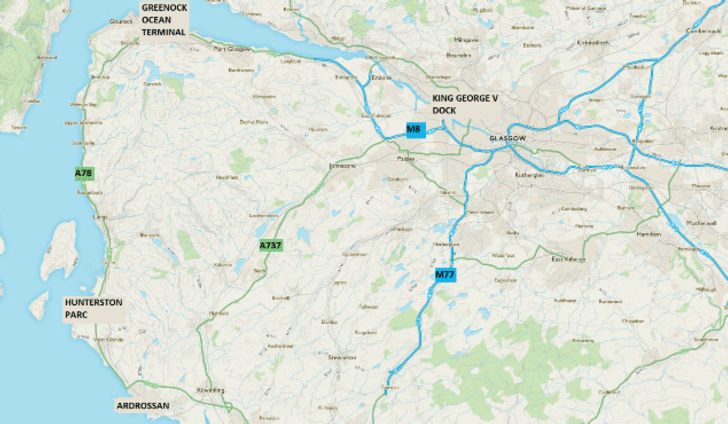
Clydeport is part of the Peel Ports Group, one of the largest port operators in the United Kingdom. Its locations on the west coast are well linked to transport networks allowing it to serve a variety Scottish businesses, improving the journey times of goods from Scotland to the rest of the world. The ports boast the deepest sea entrance in northern Europe at Greenock Ocean Terminal, as well as the busiest cruise terminal in Scotland at King George V Dock.
Clydeport's terminals are King George V Dock, Greenock Ocean Terminal, Hunterston Port and Recreation Centre (PARC) and Ardrossan. The ports have experience in handling containers, forest products, bulk agricultural products, and project & bulk cargo.
Greenock Ocean Terminal
The terminal is located on the west coast, and is easily accessible via the A78 trunk road. The quay spans 372 metres, with water depth at 12.6 metres. Three ship-to-shore cranes - an integral part of the Greenock skyline - can lift 35-40 tonnes and 13 containers across. Greenock Ocean Terminal's 50 acre site has laden storage of up to 7,000 Twenty-foot Equivalent Units[48] (TEU's) and empty storage of up to 3,500 TEU's. An additional benefit is the 25,000m2 multi-user warehouse with up to 80 refrigerated points and devanning facilities[49] on site. Although terminal capacity is less than larger European ports such as Rotterdam, which moved 12.8 million TEU's in 2017, this is significant for Scotland.
King George V Dock
The multi-user port terminal is located just west of Glasgow City Centre, close to Scotland's extensive rail and motorway network, allowing for efficient distribution of cargo within and outwith Scotland. The versatile dock, which opened in July of 1931, features 32.6 hectares of outside storage and 6 hectares of sheltered storage space. King George V dock also boasts a 1586m long quay including a 529m long riverside quay with a water depth of 8.5m.
Edinburgh Airport
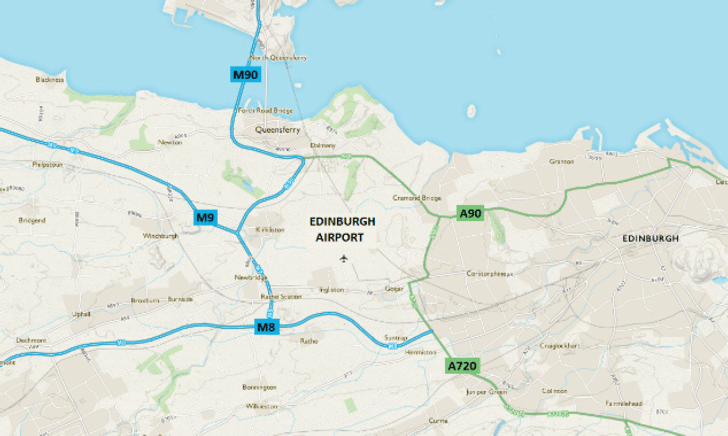
The airport is located 5 miles west of Edinburgh city centre and close to the M8 and M9 motorways. It is owned and operated by Global Infrastructure Partners, who are also a shareholder of Gatwick Airport. The airport has one runway and one passenger terminal, and employs about 2,500 people.
In recent years Edinburgh Airport has become Scotland's busiest passenger airport, and is now the UK's 6th busiest airport. Since 1985 the number of passengers carried by the airport has increased tenfold. It is also the airport which handles the most freight in Scotland, although the amount of freight handled (20,316 tonnes in 2018) has remained broadly unchanged over the last 10 years[50].
Over the 5 years to 2018, Edinburgh's terminal passenger numbers have grown by 46.2%, making it the 2nd fastest growing passenger airport in Scotland[51]. With nearly 125,000 commercial air transport movements in 2018, Edinburgh Airport remains Scotland's largest passenger and freight airport.
Eurocentral
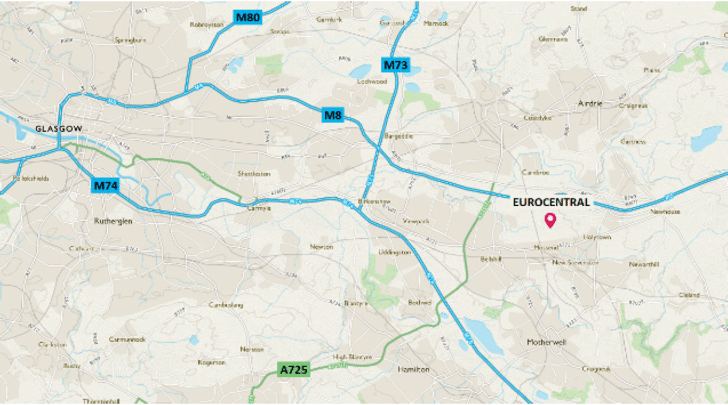
Eurocentral is Scotland's largest commercial site extending over some 650 acres and situated just off the M8 motorway, 12 miles east of Glasgow city centre and 34 miles west of Edinburgh. It is within 40 minutes by road to Edinburgh and Glasgow airports by road and within 30 miles of Greenock and Grangemouth container terminals.
Current tenants at the site include a number of logistics companies such as XPO Logistics, DX and Wincanton, as well as major retailers such as Argos, Morrisons, Next and Amazon, and is the Scottish printing press for News International.
Eurocentral is also the site of the Mossend rail terminal, and there are plans to expand this facility. The rail terminal connects with other intermodal rail freight terminals in Greenock and Grangemouth, providing links onward to England via rail freight or further afield to Europe and other international destinations by sea. Nearby Maxim Park is the UK's largest speculative office park development.
Forth Ports
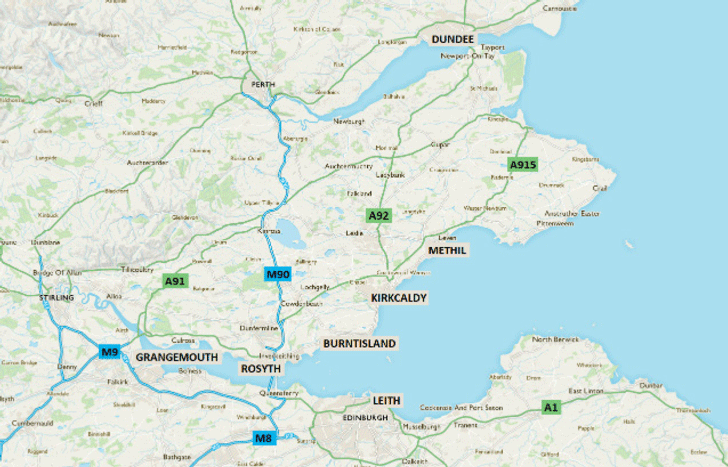
Forth Ports owns and operates seven commercial ports on the Firth of Forth, and the Firth of Tay (Grangemouth, Dundee, Leith (Edinburgh), Rosyth, Methil, Burntisland and Kirkcaldy) covering 280 square miles of navigable waters. It also owns and operates Tilbury on the Thames in South East England. The ports are located close to the trunk road network (M9, M8, M90, A1, and A720) and to Edinburgh Airport.
Forth Ports is Scotland's largest port group, with 26.6 million tonnes being handled by the port in 2018, a small decrease on 2017 (27.5 million tonnes)[52]. In 2018, Forth Ports retained its 8th position in the Top 10 UK major ports by tonnage.
A large proportion of Scottish produced goods goes through the River Forth and the River Tay, including oil and gas, food and drink, agriculture, manufacturing and renewable energy goods. Forth Ports have two specialised marine terminals for oil and gas export, and operate Scotland's largest container terminal at Grangemouth.
Freightliner's Coatbridge Terminal
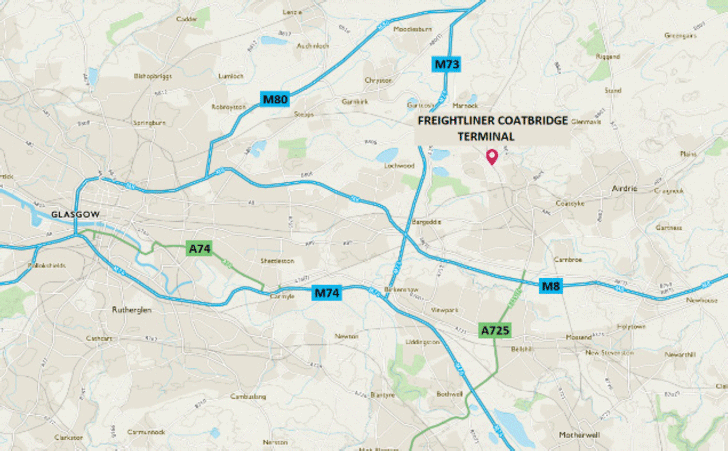
Opened in 1968, the terminal is the busiest rail container facility in Scotland and handles a considerable volume of rail freight. The 20 acre site located on the Motherwell to Inverness line on the main strategic rail freight network, between Edinburgh and Glasgow, is close to the Central Scotland trunk and motorway network and road distribution centres. Given its central location close to major Scottish exporters and principal road haulage hubs, it handles most intra-Scotland rail freight moves.
Coatbridge has become a vital hub for the movement of containers to and from Scotland. In 2018, more than 44,000 containers were handled by the terminal, lifting more than 980,000 tonnes between 2017 and 2018.
The terminal plays a vital role in supporting Scotland's exports by connecting Scottish businesses with markets all over the world. In recent years, up to 25% of Scotland's exports have passed through Coatbridge. Whisky and other major branded spirits exports destined for all parts of the globe, including North and South America, Africa, Australia and Asia, are transported on Coatbridge export trains. With rising demand around the world, whisky continues to be the largest single product moving through Coatbridge en route to Deep Sea ports.
Other major products transiting through Coatbridge include seafood, luxury textiles, iconic Scottish branded bakery items and many other everyday foods such as oats and seed potatoes to be grown and harvested overseas. With customers and hauliers able to book individual slots on trains or as many as they require – and as often as they need – Coatbridge provides a flexible rail freight solution and currently serves approximately 250 customers.
Glasgow Airport
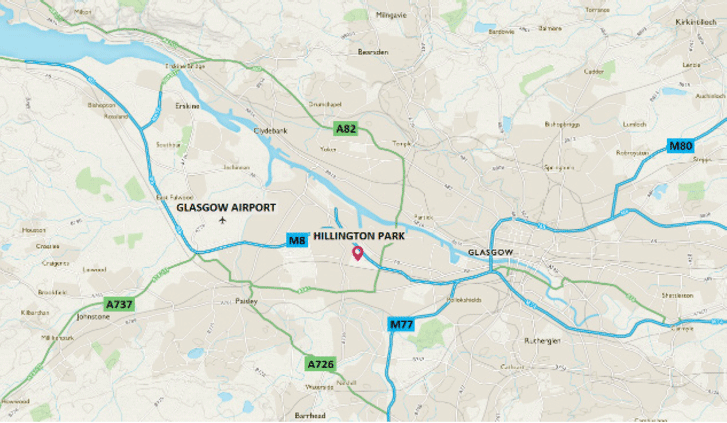
Operating hours: 24 hours a day, 365 days a year • Opened: 1966 • Runways: One main (2658m long) • Terminals: Two – our main terminal plus our smaller T2 facility • Airlines: 30 • Destinations: 100 + • Air transport movements per year: 102,000 • Passengers per year: 9.9 million • Air cargo per year: 13,033 tonnes • Status: Scotland's principal long-haul airport
Opened in May 1966 and serving Scotland for over 50 years, Glasgow Airport is based to the west of the city centre, providing flights to over 100 destinations, serving 9.7 million passengers and lifting 15,466 tonnes of air freight in 2018.
Glasgow Airport is also a major intra-Scotland hub serving more Scottish destinations than any other airport. The airport has one runway and two terminals, supporting the business of 30 different airlines.
In 2018, Glasgow accounted for 3.3% of all terminal passengers at all airports across the UK. Over the last 5 years, Glasgow Airport's passenger numbers have grown by 31% (compared to 2013), making it Scotland's 3rd fastest growing airport (of those serving more than 100,000 passengers annually).
Glasgow Prestwick Airport
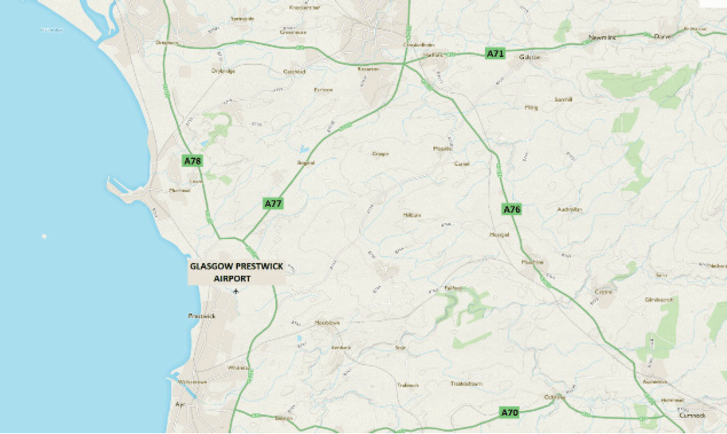
Situated 34 miles south west of Glasgow city centre, Glasgow Prestwick Airport is an important gateway for freight. The airport is currently owned by the Scottish Government. The airport employs over 320 people and a further 1,700 jobs through its supplier network. The Scottish Government see the facility as an important infrastructure asset that helps to sustain jobs in the west of Scotland (in excess of 4,000 jobs). Over 50% of the country's aerospace workforce are employed in Prestwick, although not at Prestwick Airport.
The airport is connected to the trunk road network through the nearby A77 which connects Glasgow with the port of Stranraer. It is the only Scottish airport with its own dedicated railway station, lying on the Ayrshire Coastal Line between Ayr and Glasgow.
Passenger numbers at Prestwick have declined markedly over the last 10 years (from 2.4 million annual passengers in 2008 to 681,000 in 2018) partly as a result of low cost airlines consolidating operations in principal airports.
There has also been a decline in the amount of freight carried through the airport (from 22,966 tonnes in 2008 to 13,003 tonnes in 2018). Total Scottish air freight increased over the same period.
Glensanda
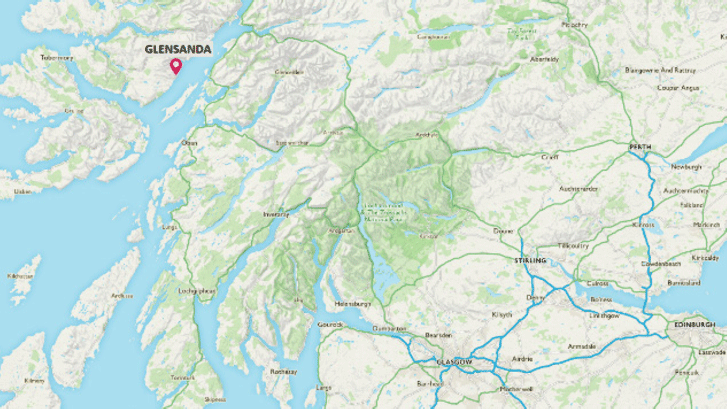
The Port of Glensanda, situated on the western shore of Loch Linnhe on the Morvern Peninsula, is operated by Aggregate Industries UK Ltd. Since road vehicles are unable to access the quarry due to its remote location, the port was established exclusively to ship out granite aggregates from the adjacent super quarry. The quarry is the largest of its kind in Europe and has an annual production capacity in excess of 9 million tonnes with a massive 760 million tonnes reserve of granite. The port is one of the UK's top ten tonnage ports, and has a fleet of its own purpose built ships which includes the Yeoman Bontrup and Yeoman Bridge. These are the largest gravity fed self-discharging bulk carriers in the world, each able to carry 100,000 tonnes of granite.[53]
Since the port opened in 1986, there have been in excess of 5,500 shipments from the port to construction projects throughout Europe, including the Channel Tunnel, Amsterdam Schipol airport, Latvia Riga airport and the London 2012 Olympic Park. It handled 6 million tonnes of granite aggregates in 2017.
Grangemouth
(See Map of Forth Ports)
One of the Forth Ports mentioned above, Grangemouth is Scotland's largest individual port, handling 9 million tonnes of cargo each year through liquid, specialist container and general cargo terminals, which handle over 225,000 TEUs each year. In 2018, it was the second largest port in the UK for handling liquid bulk goods (crude oil, oil products, liquefied gas, and other liquids).
Situated between Scotland's two largest cities – Glasgow and Edinburgh – the port is in a pivotal location for logistics and distribution, with connectivity available via road, rail and sea. It plays an integral role in Scotland's supply chain, providing a gateway for Scottish trade and facilitating the flow of more than £6 billion worth of goods each year, including food and drink, machinery, fuel, steel products, timber, paper and equipment for the oil and gas industry.
This year, a new rail freight service linking the South East of England with Central Scotland was opened between Tilbury and Grangemouth. The service will leave Tilbury on a Friday and will travel via Daventry overnight, arriving at Grangemouth on a Saturday. The roundtrip distance for the journey is more than 800 miles.
The service has a capacity to travel with up to thirty-six 45 foot containers. Northbound loads will include retail goods, food and drink. The southbound journey from Grangemouth will support Scotland's export market with the movement of spirits, chemicals and fresh food including potatoes.
Hillington Park
(See Map of Glasgow Airport)
Established in 1938, Hillington Park is Scotland's largest business park and home to over 500 organisations with associated employment of over 8,000 people[54]. Frasers Property acquired Hillington Park in November 2017. Located on the M8 between Glasgow City Centre and Glasgow International Airport, it is also well serviced by two rail freight terminals.
Current tenants at the site include a number of logistics companies. JG Russell, one of Scotland's largest logistics firms, operate a large freight park with over 250 vehicles and 1000 trailers at Hillington Park[55], alongside bases for smaller logistics firms such as MIQ and SEKO, and a range of large retailers.
Inverness Airport Business Park (IABP)
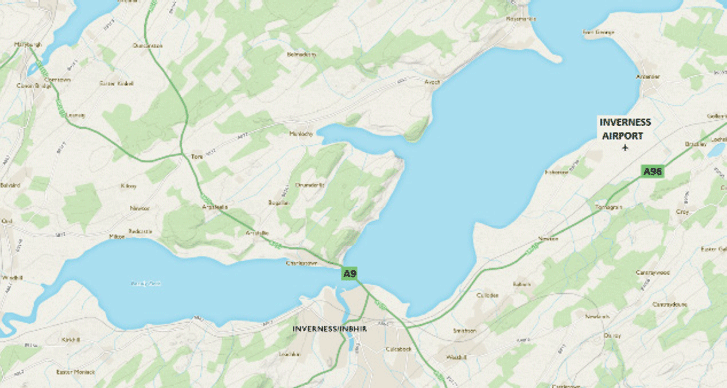
Inverness is often badged as one of Europe's fastest growing cities and Scotland's gateway to the Northern Isles and Highlands. The IABP is a business hub located to the east of Inverness Airport, providing individuals and businesses with transport links including air, road and rail connectivity.
Inverness Airport handled over 40 scheduled commercial flights each day, carrying 893,000 passengers in 2018. Inverness is also a leading airport for business aviation with a large number of private flights each year.
The business park provides accessibility by road and is hugely important for the movement of goods and services across the North of Scotland. This key strategic location offers direct access to the A96 Corridor, with the full Inverness to Aberdeen route scheduled to be dualled by 2030. IABP is only 8 miles from the A9, Scotland's longest trunk road, where the construction of the new A9/A96 Link Road & Longman Interchange should greatly improve connecting travel times. The £3bn A9 upgrade and dualling between Inverness and Perth started in 2015 with project completion scheduled for 2025.
The Inverness Airport (Dalcross) railway station was approved by Highland Council in February 2017. The new development plan includes two platforms and double tracking from the outset. The station will be located within the IABP alongside airside and railside development sites.
These recent developments and ongoing projects further emphasise the importance that this hub will play in the movement of goods between the North and South of Scotland.
Orkney Islands Harbour Authority
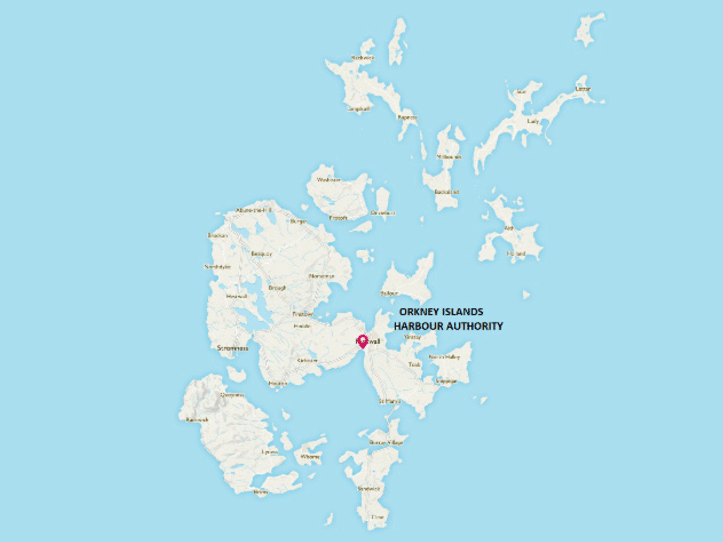
The Orkney Islands Harbour Authority operates 29 piers and harbours across the Orkney Islands. This includes Scapa Flow, at 125 square miles. Some of the smaller harbours operated by Authority provide local inter-island ferry services, while the larger ferry terminals at Kirkwall, Stromness, and St Margaret's Head connect the main island to the Scottish mainland. The amount of port freight leaving Orkney fell by 28% compared to 2017 to 3.5 million tonnes in 2018[56].
The Orkney Islands is a popular cruise ship destination in the UK, with over 140 cruise ships calling into Kirkwall and Stromness annually en route to destinations including Iceland, Norway, Denmark and Germany as well as around Scotland's Highlands and Islands.
Ship-to-Ship operations of crude oil cargo have been conducted in Scapa Flow since 1980. The deep, sheltered water of Scapa Flow and its sheer expanse holds around 1 billion cubic metres of water, which offers sheltered, swell and tidal stream free anchorage unrivalled in northern Europe. In 2007, a historic milestone was reached when the world's first Ship to Ship transfer of liquefied natural gas took place in Scapa Flow[57].
Hatston Pier, just outside Kirkwall, is Scotland's longest deep-water commercial berth. It attracts oil and gas support vessels, some of the world's largest cruise shipping, freight and passenger ferry services and a sheltered berthing facility with extensive quay space for short term operational and maintenance activity for the marine renewable industry.
Furthermore, Orkney is home to the largest crab processing plant in Europe. It is not just the oil and gas industry that benefits from the deep sheltered waters of Scapa Flow. Commercial fishing for prawn, crab, lobster and scallop and the recent development of large scale salmon farms contribute significant commercial value to the local economy. These premium products are shipped to restaurants across Europe.
There is a robust freight service from the islands to the mainland, although as with other maritime freight routes, it is difficult to ascertain the end destination of the freight itself after it reaches the mainland. The Serco Northlink Ferry (SNF) Service operates frequent freight and passenger services from Kirkwall to Aberdeen and daily services from Stromness to Scrabster. Pentland Ferries also operate a daily service between St. Margaret's Hope on Orkney and Gills Bay on the Scottish Mainland, presumed to carry around 80% of all livestock and dangerous goods cargo between the Orkney Islands and the Scottish mainland.